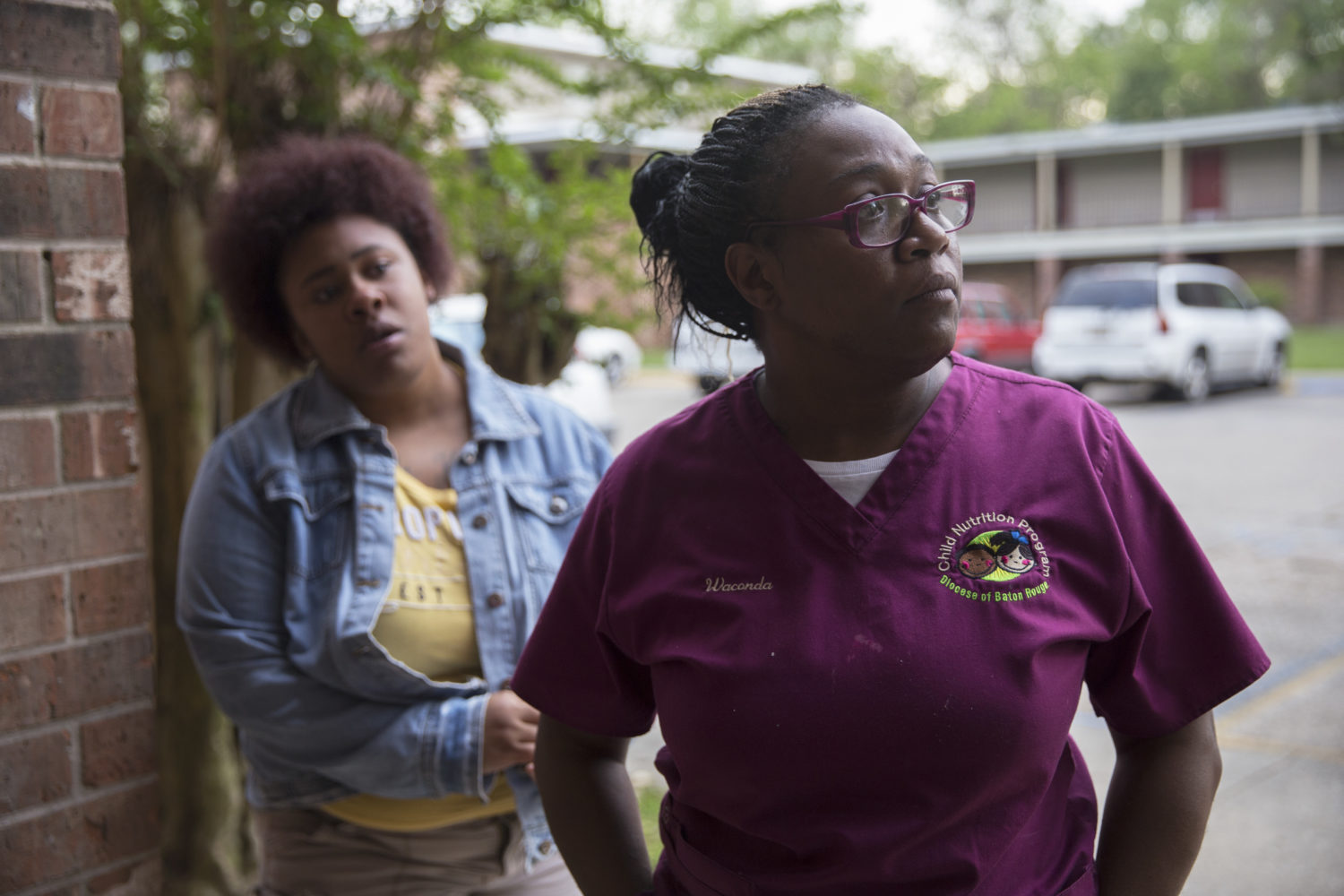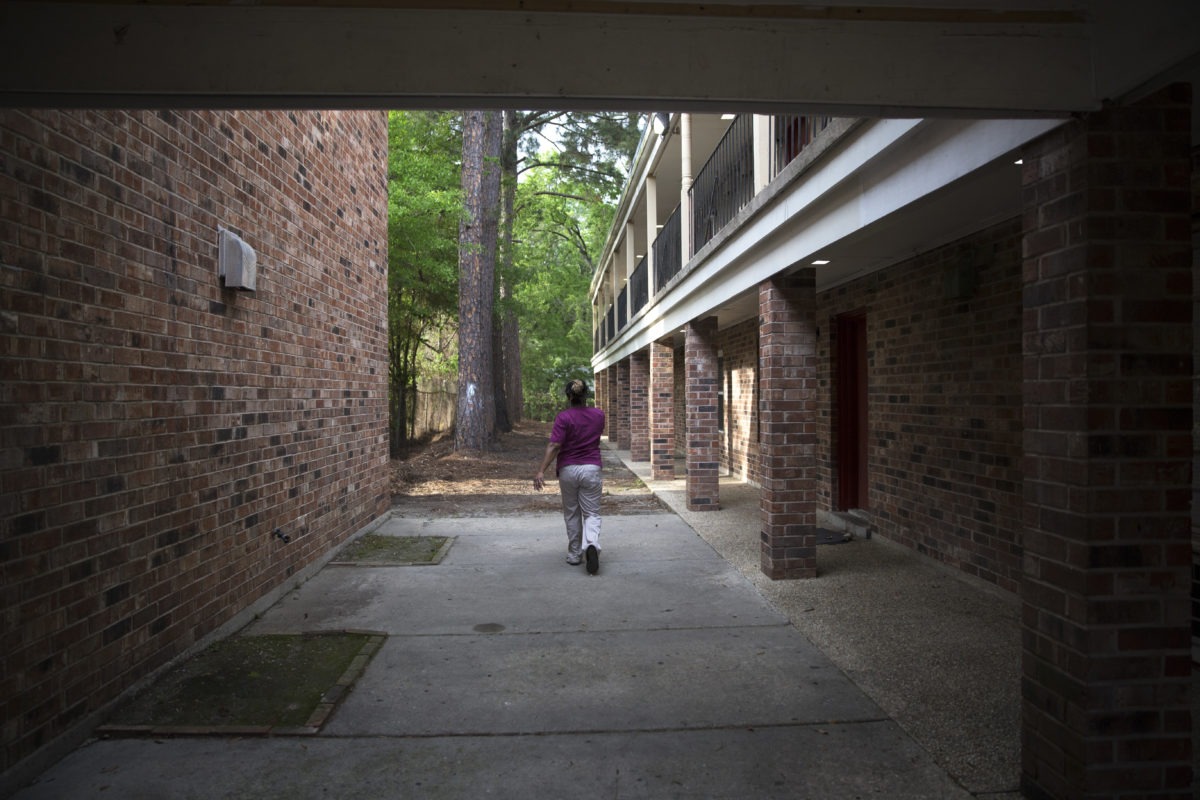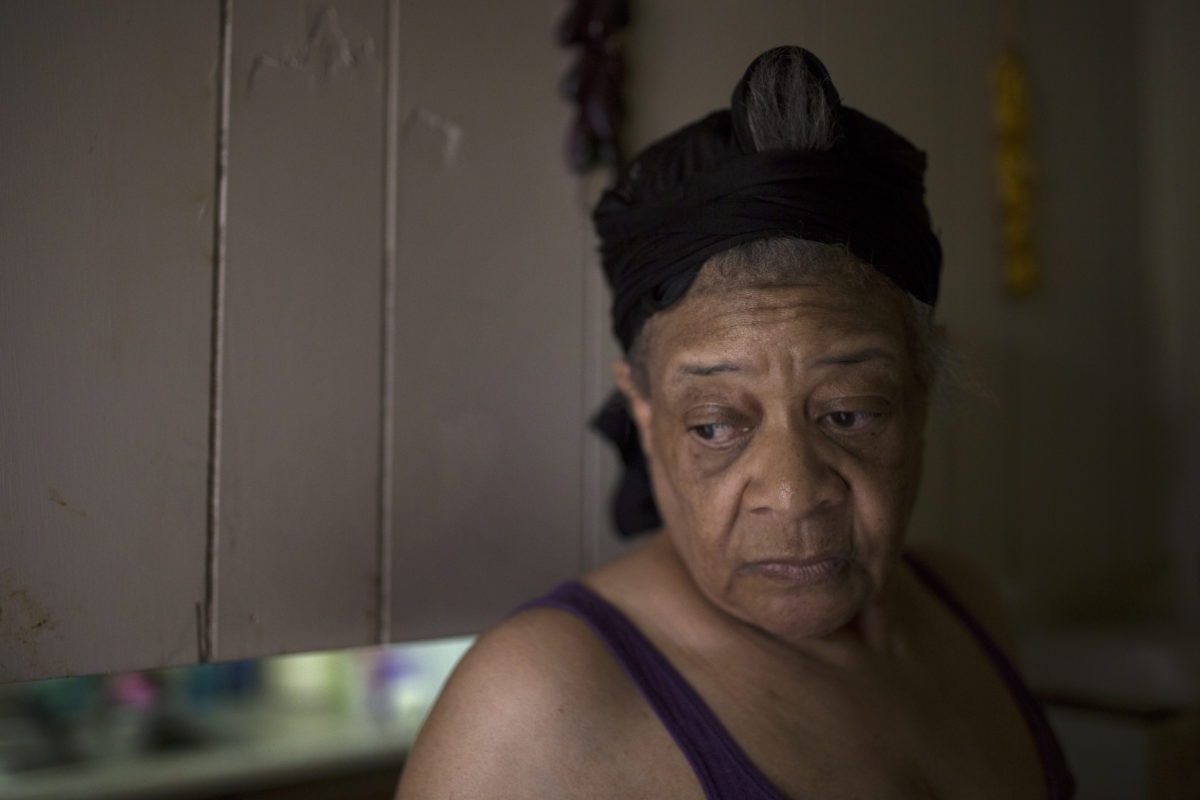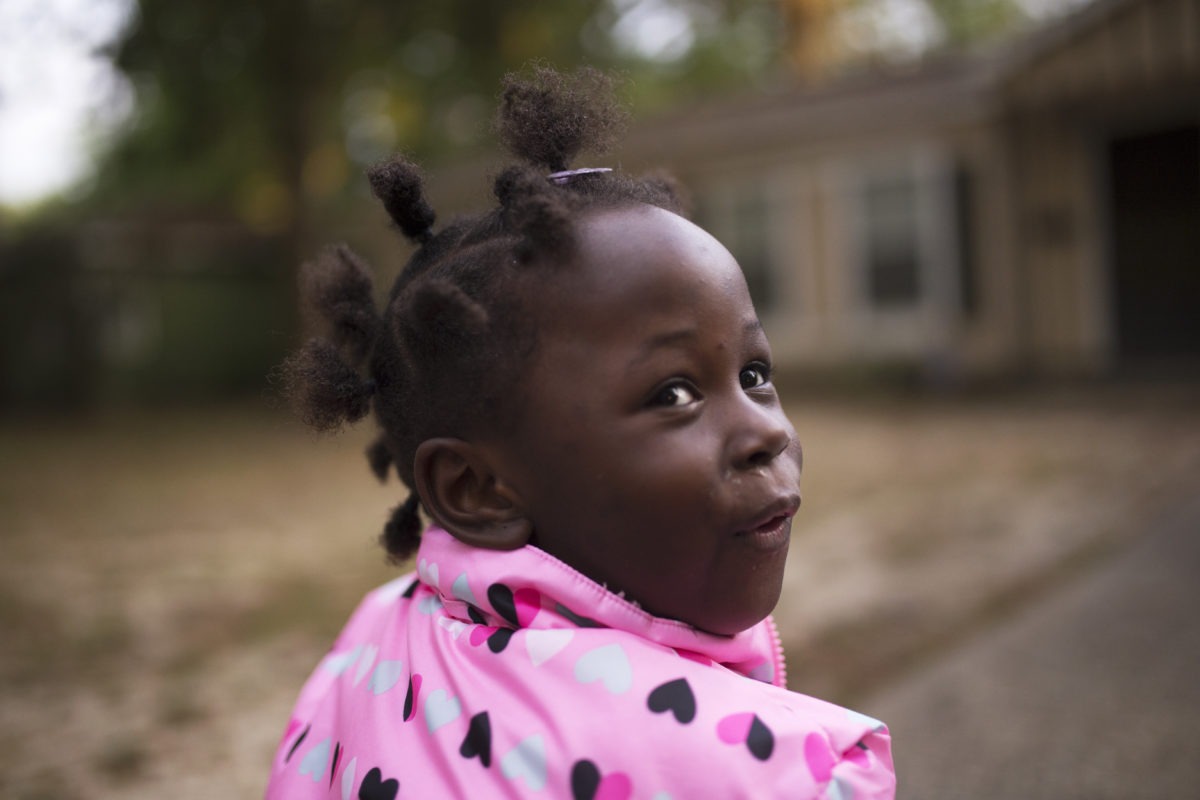A Year After Police Shot Calvin Toney, His Family Still Doesn’t Know What Happened
Baton Rouge residents say little has changed after Alton Sterling.

The mother stalked the outdoor corridors of The Palms Apartments, a hardscrabble complex in the north side of Baton Rouge, Louisiana, looking for answers.
She knocked on a door. No one came. She continued with her grim tour.
“See up there,” she said indicating where security cameras were mounted. “That’s the cameras. Those are the ones the BRPD took,” she said, referring to the Baton Rouge Police Department. “We haven’t seen anything from them, nothing. And we probably never will.”
She went to another door. This time a young woman answered.
“I’m sorry. Hey, love, how’re you doing,” she said. “Is there an older lady that lives here? She sleeping? This is Pam, the lady whose son that got killed out here.”
The woman shook her head ‘no’ and closed the door.
It had been six months since Pam Toney’s son, Calvin Toney, was shot in that very spot by a Baton Rouge police officer. As she walked the corridor, she stopped for a moment to point out where her son’s blood pooled up and leaked like rain run off into cracks in the pavement.
She was frustrated. She had been told by residents and activists that the management from the company threatened to evict people if they talked about what they had seen the night her son was killed. She was convinced that someone had seen something but was just too scared to come forward.
She started to scream loud enough so that the whole complex could hear her.
“I know you can hear me! You can hear me. Your windows open,” her voice filled with anger.
Toney’s voice reached a crescendo as she walked into the courtyard.
“And you, you over there,” she shouted at a group of young men gathered nearby. “I know you can hear me. And the rest of you can, too. I get loud when I’m angry. And I’m angry. They killed my son. Murdered him.”
She paused to gather herself.
“The whole city needs to know,” she yelled. “The whole world needs to know. Or there will never be no justice in Baton Rouge!”
Secure the scene
This is the official version of events pieced together from reports and statements made by public officials in the weeks after the incident: On the evening of Nov. 13, 2017, Officer Darrell Carter Jr. was accompanying a caseworker from the Department of Children and Family Services to the Palms Apartments in North Baton Rouge, where Calvin Toney lived with his girlfriend, to investigate child abuse allegations.
When they arrived, only Calvin Toney was home. He tried to run, they said, and there was an altercation during which Carter tased Toney multiple times and Toney attempted to grab the officer’s Taser. Carter shot him once in the chest. Toney then tried to run again but was ultimately subdued and handcuffed. He died on the scene.
As it does with all BRPD-involved shootings, the Louisiana State Police investigated the killing. The agency then turned over its findings to East Baton Rouge District Attorney Hillar C. Moore III’s office. Moore’s office declined to comment because the case was still under review.
At its core, the dispute between Toney’s family and the BRPD boils down to two central questions. First, was Toney handcuffed when he was shot to death? And second, after a year, will anybody be held accountable?

The most comprehensive statement about the shooting came during an award ceremony in May when Officer Carter received a medal of valor for how he handled the incident. According to local news sources, the award describes what happened as a fight over a Taser. Carter loudly told Toney to drop the Taser, and then Carter fired a fatal shot.
“He was able to draw and discharge his service weapon, firing a shot into the chest of the individual,” the award reads. “After a foot pursuit, Officer Carter was able to take the individual into custody and secure the scene.”
‘Swept under the rug’
Pam Toney went looking for answers on the afternoon of March 27, the same day that state Attorney General Jeff Landry announced that there would be no charges against the two BRPD officers involved in the shooting death of Alton Sterling in 2016. Sterling was selling bootleg CDs outside the Triple S Food Mart in North Baton Rouge when he was approached by the officers, Blane Salamoni and Howie Lake. During the altercation, Salamoni shot Sterling six times, killing him. Video of the shooting spread, sparking protests in Baton Rouge and nationwide.
The announcement shredded what hope for justice she had left, Pam Toney said.
“It’s making me feel that the officer that killed my son is going to get off with it,” she said. ”That’s how I feel. If they kill Alton Sterling cold-blooded right on camera, we’re not going to stand a chance.”
It has been more than a year now. Pam Toney is no closer to getting answers from the city and state police departments, the district attorney’s office or City Hall. The Toney family worries that Calvin’s death, a shooting not as widely publicized as Sterling’s, will be, in his mother’s words, “swept under the rug.”
The night Calvin Toney was killed, memories of the Sterling shooting were in the air as angry crowds formed around the perimeter of the scene. City leaders came out to try to prevent the tensions from boiling over. Among them was Baton Rouge Mayor-President Sharon Weston Broome. Broome was elected after the Sterling shooting and made a commitment to bring transparency to the BRPD.
“What is so vitally important is that we keep the lines of communication open with the community and that they know a thorough investigation is taking place,” she said the morning after the Toney shooting in a news television interview. “It’s very important that transparency and truth remain the ultimate goal in this investigation.”
So far it has been anything but transparent. The obfuscation that plagued the Sterling investigation continues in the BRPD today, many police reform activists and members of the community say.
That is why Calvin Toney’s mother still walks the corridor where her son was killed, looking for answers. She has asked for the body cam footage but it remains in the hands of the Baton Rouge police and the state police. The same goes for the Palms Apartments’ security footage, which Pam Toney said she saw BRPD investigators take the day after the shooting. She has asked for some clarity on the investigation being conducted by the DA’s office but she’s heard nothing from them. A spokesman for the Baton Rouge police declined to comment and referred questions to the state police. That office declined to comment, saying the case was still under review. The East Baton Rouge Parish district attorney’s office declined to comment for the same reason.
If they kill Alton Sterling cold-blooded right on camera, we’re not going to stand a chance.
Pam Toney mother of police shooting victim Calvin Toney
Amid the silence from the BRPD, the DA, and city officials, rumors began to swirl that Toney had been shot while he was handcuffed. A woman who lives in an apartment right next to where Toney was killed has added fuel to the suspicions. Months after the shooting, Cora Spears, 66, told The Appeal her version of the night that departs from the official story in one important detail.
“He was already handcuffed when he shot him!” Spears said. His hands were “already cuffed and they was cuffed tight.”
Spears recounted that evening during an interview in March, a few days after the Sterling announcement. “They killed him,” she said. “He stayed there so long and he was just grunt,” she said trying to mimic the desperate noises he made while he was dying. “Just grunt,” she repeated.
Spears said she was sitting down on her couch in her ground floor apartment to enjoy a homemade dinner of pork chops and fries when she heard a loud scuffle coming from the walkway outside. She put down her plate and went to the bedroom window to see what was going on. Peeking out the between the curtains, Spears said she saw a uniformed Baton Rouge Police officer run past her window then “POW!” she exclaimed.
“They shooting out there!” Spears yelled to her roommate who was still on the couch. Within seconds she had run to the front door and opened it.
Just yards away on the grass next to the walkway, the officer was standing over a young man. She recognized the young man: Calvin Toney, who lived a couple of doors down. They had spoken just days earlier when Spears passed him on her way back from the grocery store.
Now Toney was lying on the grass bleeding from a gunshot wound, his pants down at his ankles. And his hands, said Spears, were cuffed behind his back.
“Man, fuck. What you shot me for?” she said Toney said to the officer. “Man, man, help. Uncuff me, uncuff me, uncuff me,” he said.
Spears stood quietly in the doorway watching them. Nobody had noticed her yet
“I feel so sorry for him,” she said. “He was trying to raise up, but you know it’s hard for your to brace yourself when your handcuffed to the back.”

She stood there for a few minutes and said she heard him ask for water. The cops didn’t look as though they were going to get it for him, she said, so she ran inside and grabbed a bottle. She gave it to them hoping they would give him a drink.
Other people from the building had heard the shot and gathered. More officers arrived and sent the residents away in an attempt to control the scene. She was ushered back inside her apartment and told by an officer to shut the door.
Later that evening investigators knocked on her door. They asked if she had seen anything. Spears said she told them she hadn’t. When she recounted the incident months later, she explained why she was reluctant to speak to the police that night. She felt more could have been done to save Calvin Toney’s life and she didn’t want to get involved, she said.
“They try to smother a lot of things that happen,” she said.
Spears said that she was coming forward now since the family is still struggling to find out the truth. She felt that it’s important that they know.
“It didn’t go down properly and I thought somebody should know so they could try to tell the family,” she said. “Let people know. Let the world know.”
Rumors fly
Calvin Toney’s younger sister Kajala has many photos of her brother on her phone. She periodically swipes through them with her mother when they want to remember him. They were going through these old pictures after looking for answers at The Palms Apartments that day in March. When they arrived at one in particular, though, Pam had to turn away.
“Oh, Lord,” she said, asking her daughter to close the phone. “I can’t even look at my son’s own picture—it hurts so bad.”
The photo, which was circulated on social media, is from the night of his death. It looks like it was taken from the balcony on the floor above. In it, Calvin Toney is sitting on the ground, his hands cuffed behind his back and his pants down by his ankles. Behind him are two Baton Rouge police officers. One of the officers, a white woman with her hair in a bun, is shining a flashlight on Toney’s back while she examines his gunshot wound with a gloved hand. Another officer stands next to her watching. The image of Toney on the ground, handcuffed with his pants around his ankles, matches what Spears remembers from that night when she peeked her head out of her door.
Right after the shooting, the photo began circulating on social media and word spread. A crowd of people gathered at the apartment complex, chanting and pressing up against the yellow police tape blocking off the scene. The picture taken that night contributed to the furor. As the unrest intensified, residents began wondering whether Calvin Toney was shot while handcuffed.
During a short press conference at the scene, state police Senior Trooper Bryan Lee attempted to put an end to those rumors.
“Our preliminary investigation shows that the suspect was not handcuffed at the time that he was shot,” Lee responded to a reporter’s question.
A day later Colonel Kevin Reeves of the state police repeated that sentiment to the public saying that Toney “was handcuffed for officer safety and for the safety of him.”
The rival accounts of how Toney died speak to the crisis of trust between Black residents and the police department charged with protecting them. Many feel that they cannot trust their own police department and that there’s no accountability when the police abuse their power. What they described as the BRPD’s disregard for Black life exhibited by Sterling’s death was nothing new in Baton Rouge, activists and residents said. Sterling’s shooting was just the first time that it had been recorded and broadcast around the world.
“They don’t have no type of justice for us out here and they just going to handle us the way that they see fit to handle us,” said Rosalyn Scott, a police reform activist in the city. “The Black community does not have any trust in the police and any respect for the policies… They’re not protecting us and they not serving us; they’re straight killing us.”
‘Deep rooted’ acrimony
The department built a reputation for racial discrimination long before Sterling’s death grabbed national attention. Baton Rouge remains one of the last police departments in Louisiana that remains under a Department of Justice consent decree imposed in 1980. The decree was imposed to compel dozens of cities across the state to make its police departments more diverse. The department remains 65 percent white, despite the city being 55 percent black and 37 percent white.
After Hurricane Katrina, state troopers from New Mexico and Michigan who had been sent to help with evacuations refused to work with the BRPD after witnessing what they described as racist policing, and abuse and harassment of Black residents. And in 2014, a BRPD officer was forced to resign for sending racist text messages that called Black residents “monkeys” and said he would like to “pull a Ferguson on them.”
In 2016, Baton Rouge police responded to protests of Sterling’s shooting with overwhelming force. They responded to a demonstration organized by young, local activists with tanks equipped with blaring long-range sound. Platoons of officers in full riot gear pointed long guns at protesters and made mass arrests, including of journalists covering the protests. Most of the arrests were never prosecuted.
More than two years after Sterling’s death, Baton Rouge had a Black police chief and a Black mayor. But many activists and residents say the new leadership has done nothing to change the acrimony between the police and the Black community.
“It’s deep-rooted,” Michael McClanahan, president of the Baton Rouge branch of the NAACP, said in an interview in his office.
McClanahan said it is going to take more than a single election or a cosmetic change in leadership to transform the department. Without getting rid of the people within the department who perpetuate the racist culture that stems from the city’s history as the capital of a slave state, nothing will change, he said. He even went as far as saying that the only answer might be to get rid of the BRPD altogether and rely on the other law enforcement agencies already operating in the city.
“If there’s no way to work it out where we can have more transparency, disband them to fix it,” he said. “Somebody just need to sit down and formulate what law enforcement should look like in the city if the BRPD was to go.”
Baton Rouge has introduced sweeping policy changes in the years since Sterling’s shooting, and there has been soaring rhetoric from politicians about transparency and openness. The BRPD now has a codified use of force policy that prioritizes de-escalation before force can be deployed. Body cameras were expanded from a limited pilot program to the whole department under the supervision of a body camera committee.
But none of those policy changes are being put into practice meaningfully, residents and activists said. The department has typically stalled on releasing body camera footage since the Sterling shooting, citing the need to complete any investigation and ensure the footage would not interfere with prosecution. Sometimes, officers say the cameras were never turned on. In August, amid calls for greater transparency, the department said it would expedite footage from officer-involved shootings and decide whether to release it to the public within 12 days. But the decision is ultimately at the discretion of the police chief.
In a news release the police department stated: “Once the chief decides that the release will not interfere with the integrity of the investigation and/or prosecution, the Baton Rouge Police Department shall release the critical incident video evidence as soon as possible.”
What happened to Sterling was not new, and since his death, activists said, it has remained business as usual.
“Nothing has changed,” Scott said. “Nothing.”
‘That’s called murder’
Gary Chambers, an activist who organizes around police-community relations, was there the night Toney died. When he got to the scene, the crowd at The Palms Apartments had already started forming. Residents were upset, he said. He remembered an officer making faces, taunting the crowd. He asked a higher-ranking officer to intervene and the officer did.
Chambers, who has been vocal about improving the relationship between the police department and the Black community, said the shooting and subsequent investigation illustrated how far the city and its police department have to go.
“I just don’t see how they can escape giving an answer and think that’s OK,” said Chambers, who is also the publisher of the Rouge Collection, a media platform where he publishes his critiques of the police department and the city’s political establishment.

Chambers said after what happened with the Sterling investigation that he was disappointed but not surprised by the city’s opacity in the Toney case.
“This is what happens in Baton Rouge. We pretend that we’re progressive,” he said. “But here’s a clear cut case where a man had an encounter with a police officer, he was killed and there’s not an ounce of transparency in the investigation.”
Chambers’s answer was swift and unequivocal when asked what he thought should happened if it turns out that Calvin Toney was handcuffed before he was shot.
“That’s called murder,” he said without hesitation. “If the cop shot him handcuffed, that’s murder,” he said. “If this guy was handcuffed there’s nothing that a police officer can tell me to justify shooting a man that’s handcuffed.”
There’s no going home again
Pam Toney never wanted to move from her little house in Brookstown, a development in the predominantly Black area of North Baton Rouge. She was happy there. It had a small town feeling that she appreciated.
“I loved my little neighborhood,” she said. “Everybody know each other.”
But she couldn’t handle the ghosts. She would see her dead son everywhere in the house. She pointed to the yard where Calvin’s football teammates would hang out.
“It used to be a yard full of people, I’m talking full of people,” she said. “My son used to be standing right there, right there.” Her voice swelled with emotion at the memory.
A few days after Christmas last year she moved out.
She still occasionally goes by the old house.
“Sometimes I just come here to just sit and think and one day the door is going to open and he’ll say ‘Ma’ and call my name,” she said. “But I’ll never hear that again.”
After the emotionally exhausting afternoon at The Palms Apartments, Toney, her brother, her daughter and Calvin’s 3-year-old daughter, Calie Knight, wound up in front of their old home.
Calie playfully begged to go in. Toney winced at the request.
“No, baby,” she said to her granddaughter. “I ain’t never going back in there, Calie.”
She doesn’t know that her dad was shot to death, Toney said. She thinks he’s working somewhere out of town.
Toney told her family to get back in the car. It’s time to go to their new home. She said she is still paranoid about letting anyone know where she moved. She doesn’t know who to trust—especially the police, she added.
“I’m not going to take anyone to the new house until we’re comfortable,” she said. “But people need to know what is really going on.”
